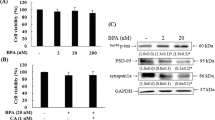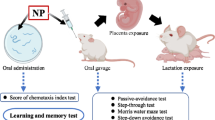Abstract
Nonylphenol (NP) is widely used in the chemical industry; it accumulates in organisms through environmental contamination and causes learning memory impairment. Nicotinamide mononucleotide (NMN) has been found to have a positive effect on the treatment of central nervous-related diseases. This study aimed to investigate the protective effect of NMN on NP-induced learning memory-related impairment in vitro and to further identify the underlying mechanisms. The results showed that NP induced oxidative stress and impaired the cholinergic system, 5-HT system in PC-12 cells. NMN alleviated NP-induced learning and memory impairment at the molecular level through alleviating oxidative stress and protective effects on the 5-HT system and cholinergic system. The 50 μM NP group significantly reduced the NAD+ content, and the relative expression of SIRT1, PGC-1α, Nrf2, MAOA, BDNF, and p-TrkB were significantly downregulated. Co-treatment of NMN with NP significantly reduced oxidative stress, improved the homeostasis of 5-HT and cholinergic system, enhanced the intracellular NAD+ content, and significantly upregulated the expression of SIRT1 pathway proteins. SIRT1 inhibitors reduced the expression of SIRT1 pathway-related proteins, which implied the impairment of learning and memory by NP and the protective effect of NMN might be achieved through the SIRT1-mediated PGC-1α/MAOA/BDNF signaling pathway. Overall, this study not only help us to understand the toxic mechanism of NP on learning memory impairment in vitro, but also have important reference significance to further explore the health care value of NMN and promote the development of related functional foods.









Similar content being viewed by others
Data Availability
All data generated during this study are available from the corresponding author on reasonable request.
References
Squire LR (2004) Memory systems of the brain: a brief history and current perspective. Neurobiol Learn Mem 82(3):171–177
de Bruin W et al (2019) Occurrence, fate and toxic effects of the industrial endocrine disrupter, nonylphenol, on plants - a review. Ecotoxicol Environ Safety 181:419–427
Langford KH et al (2005) The partitioning of alkylphenolic surfactants and polybrominated diphenyl ether flame retardants in activated sludge batch tests. Chemosphere 61(9):1221–1230
Fries E, Puttmann W (2003) Occurrence and behaviour of 4-nonylphenol in river water of Germany. J Environ Monit 5(4):598–603
Sabik H et al (2003) Occurrence of alkylphenol polyethoxylates in the St. Lawrence River and their bioconcentration by mussels (Elliptio complanata). Chemosphere 51(5):349–356
Nowak KM et al (2008) Effect of sludge treatment on the bioaccumulation of nonylphenol in grass grown on sludge-amended soil. Environ Chem Lett 6(1):53–58
Ying GG, Williams B, Kookana R (2002) Environmental fate of alkylphenols and alkylphenol ethoxylates - a review. Environ Int 28(3):215–226
Vieira WT et al (2020) Removal of endocrine disruptors in waters by adsorption, membrane filtration and biodegradation. A review. Environ Chem Lett 18(4):1113–1143
Dsikowitzky L, Schwarzbauer J (2014) Industrial organic contaminants: identification, toxicity and fate in the environment. Environ Chem Lett 12(3):371–386
Zhou et al. (2018) Easier removal of nonylphenol and naphthalene pollutants in wet weather revealed by Markov chains modeling. Environ Chem Lett 16(3):1089–1093. https://doi.org/10.1007/s10311-018-0728-5
Snedeker SM, Hay AG (2014) The alkylphenols nonylphenol and octylphenol in food contact materials and household items: exposure and health risk considerations. Springer, London
Park JH et al (2016) Nicotinamide mononucleotide inhibits post-ischemic NAD+ degradation and dramatically ameliorates brain damage following global cerebral ischemia. Neurobiol Dis 95:102–110
Wang X et al (2016) Nicotinamide mononucleotide protects against beta-amyloid oligomer-induced cognitive impairment and neuronal death. Brain Res 1643:1–9
Yao ZW et al (2017) Nicotinamide mononucleotide inhibits JNK activation to reverse Alzheimer disease. Neurosci Lett 647:133–140
Diao P et al (2017) Phenolic endocrine-disrupting compounds in the Pearl River Estuary: occurrence, bioaccumulation and risk assessment. Sci Total Environ 584–585:1100–1107
Lotfi M et al (2021) The investigation into neurotoxicity mechanisms of nonylphenol: a narrative review. Curr Neuropharmacol 19(8):1345–1353
Ravni A et al (2006) The neurotrophic effects of PACAP in PC12 cells: control by multiple transduction pathways. J Neurochem 98(2):321–329
Vaudry D, et al (2002) PC12 cells as a model to study the neurotrophic activities of PACAP, D.T. OConnor and L.E. Eiden, D.T. OConnor and L.E. Eiden^Editors. 11th International Symposium on Chromaffin Cell Biology. 491–496
Mussina K, Toktarkhanova D, Filchakova O (2021) Nicotinic acetylcholine receptors of PC12 cells. Cell Mol Neurobiol 41(1):17–29
Nishimura Y, Nagao T, Fukushima N (2014) Long-term pre-exposure of pheochromocytoma PC12 cells to endocrine-disrupting chemicals influences neuronal differentiation. Neurosci Lett 570:1–4
Huang RX, Tao J (2020) Nicotinamide mononucleotide attenuates glucocorticoid-induced osteogenic inhibition by regulating the SIRT1/PGC-1 alpha signaling pathway. Mol Med Rep 22(1):145–154
Yoo KH et al (2021) Nicotinamide mononucleotide prevents cisplatin-induced cognitive impairments. Can Res 81(13):3727–3737
Mills KF et al (2016) Long-term administration of nicotinamide mononucleotide mitigates age-associated physiological decline in mice. Cell Metab 24(6):795–806
Sharma M, Gupta YK (2002) Chronic treatment with trans resveratrol prevents intracerebroventricular streptozotocin induced cognitive impairment and oxidative stress in rats. Life Sci (1973) 71(21):2489–2498
Glade MJ (2010) Oxidative stress and cognitive longevity. Nutrition 26(6):595–603
Ito S et al (2020) Protective effects of nicotinamide mononucleotide against oxidative stress-induced PC12 cell death via mitochondrial enhancement. PharmaNutrition 11:100175
Deng X et al (2021) Nicotinamide mononucleotide (NMN) protects bEnd.3 cells against H2 O2 -induced damage via NAMPT and the NF-kappaB p65 signalling pathway. FEBS Open Bio 11(3):866–879
Al-Zahrani SSA et al (1996) Effect of destruction of the 5-hydroxytryptaminergic pathways on the acquisition of temporal discrimination and memory for duration in a delayed conditional discrimination task. Psychopharmacologia 123(1):103–110
Blazevic S et al (2012) Anxiety-like behavior and cognitive flexibility in adult rats perinatally exposed to increased serotonin concentrations. Behav Brain Res 230(1):175–181
Gold CA, Budson AE (2008) Memory loss in Alzheimer’s disease: implications for development of therapeutics. Expert Rev Neurother 8(12):1879–1891
Haam J, Yakel JL (2017) Cholinergic modulation of the hippocampal region and memory fuction. J Neurochem 142:111–121
Berger-Sweeney J et al (2001) Selective immunolesions of cholinergic neurons in mice: effects on neuroanatomy, neurochemistry, and behavior. J Neurosci 21(20):8164–8173
Parent MJ et al (2013) Cholinergic depletion in Alzheimer’s disease shown by [(18) F]FEOBV autoradiography. Int J Mol Imaging 2013:205045–205045
Wu D et al (2020) Neuroprotective function of a novel hexapeptide QMDDQ from shrimp via activation of the PKA/CREB/BNDF signaling pathway and its structure–activity relationship. J Agric Food Chem 68(24):6759–6769
Das A et al (2018) Impairment of an endothelial NAD+-H2S signaling network is a reversible cause of vascular aging. Cell 173(1):74-89.e20
Di Stefano M et al (2015) A rise in NAD precursor nicotinamide mononucleotide (NMN) after injury promotes axon degeneration. Cell Death Differ 22(5):731–742
Chen H et al (2013) NAD+-carrying mesoporous silica nanoparticles can prevent oxidative stress-induced energy failures of both rodent astrocytes and PC12 cells. PLoS ONE 8(9):e74100
Chen D et al (2008) The role of calorie restriction and SIRT1 in prion-mediated neurodegeneration. Exp Gerontol 43(12):1086–1093
Yoshino J et al (2011) Nicotinamide mononucleotide, a key NAD+ intermediate, treats the pathophysiology of diet- and age-induced diabetes in mice. Cell Metab 14(4):528–536
Auberval N, et al (2014) Metabolic and oxidative stress markers in Wistar rats after 2 months on a high-fat diet. Diabetol Metab Syndr 6(1):130. https://doi.org/10.1186/1758-5996-6-130
Thapa I, Fox HS, Bastola D (2015) Coexpression network analysis of miRNA-142 overexpression in neuronal cells. Biomed Res Int 2015:1–9
Arevalo JC, Wu SH (2006) Neurotrophin signaling: many exciting surprises. Cell Mol Life Sci 63(13):1523–1537
Lin J et al (2002) Transcriptional co-activator PGC-1 alpha drives the formation of slow-twitch muscle fibres. Nature 418(6899):797–801
Cho HY, Reddy SP, Kleeberger SR (2006) Nrf2 defends the lung from oxidative stress. Antioxid Redox Signal 8(1–2):76–87
Gong W et al (2017) Polydatin promotes Nrf2-ARE anti-oxidative pathway through activating CKIP-1 to resist HG-induced up-regulation of FN and ICAM-1 in GMCs and diabetic mice kidneys. Free Radic Biol Med 106:393–405
Huang K et al (2013) Sirt1 resists advanced glycation end products-induced expressions of fibronectin and TGF-beta 1 by activating the Nrf2/ARE pathway in glomerular mesangial cells. Free Radic Biol Med 65:528–540
Yang Y et al (2014) Alpha-lipoic acid improves high-fat diet-induced hepatic steatosis by modulating the transcription factors SREBP-1, FoxO1 and Nrf2 via the SIRT1/LKB1/AMPK pathway. J Nutr Biochem 25(11):1207–1217
Naoi M et al (2011) Type A monoamine oxidase regulates life and death of neurons in neurodegeneration and neuroprotection. Int Rev Neurobiol 100:85
Libert S et al (2011) SIRT1 activates MAO-A in the brain to mediate anxiety and exploratory drive. Cell 147(7):1459–1472
Kang H et al (1997) Neurotrophins and time: different roles for TrkB signaling in hippocampal long-term potentiation. Neuron (Cambridge Mass) 19(3):653–664
Croll SD et al (1998) Expression of BDNF and trkB as a function of age and cognitive performance. Brain Res 812(1):200–208
Acknowledgements
We appreciate the contribution of all the members participating in this study.
Funding
This study was supported by the Natural Science Foundation of Guangdong Province (2021A1515010825), Guangdong Key R&D Program, Department of Science and Technology of Guangdong Province (2019B020210002), Generic Technique Innovation Team Construction of Modern Agriculture of Guangdong Province (2021KJ130), and Guangdong Provincial Key Laboratory of Food Quality and Safety (2020B1212060059).
Author information
Authors and Affiliations
Contributions
Zhongyi Li: design and conduct of the cell cultural experiments, analysis of the data, and writing the manuscript.
Huan Liu: conduct the Western blotting experiments.
Wenna Han: conduct the cell cultural experiments, and analysis of the relevant data.
Siyu Zhu: conceptualization, writing-review and editing, and funding acquisition.
Chunhong Liu: supervision and funding acquisition.
Corresponding author
Ethics declarations
Ethics Approval
Not applicable.
Consent to Participate
Not applicable.
Consent for Publication
Not applicable.
Competing Interests
The authors declare no competing interests.
Additional information
Publisher's Note
Springer Nature remains neutral with regard to jurisdictional claims in published maps and institutional affiliations.
Rights and permissions
Springer Nature or its licensor (e.g. a society or other partner) holds exclusive rights to this article under a publishing agreement with the author(s) or other rightsholder(s); author self-archiving of the accepted manuscript version of this article is solely governed by the terms of such publishing agreement and applicable law.
About this article
Cite this article
Li, Z., Liu, H., Han, W. et al. NMN Alleviates NP-Induced Learning and Memory Impairment Through SIRT1 Pathway in PC-12 Cell. Mol Neurobiol 60, 2871–2883 (2023). https://doi.org/10.1007/s12035-023-03251-9
Received:
Accepted:
Published:
Issue Date:
DOI: https://doi.org/10.1007/s12035-023-03251-9




